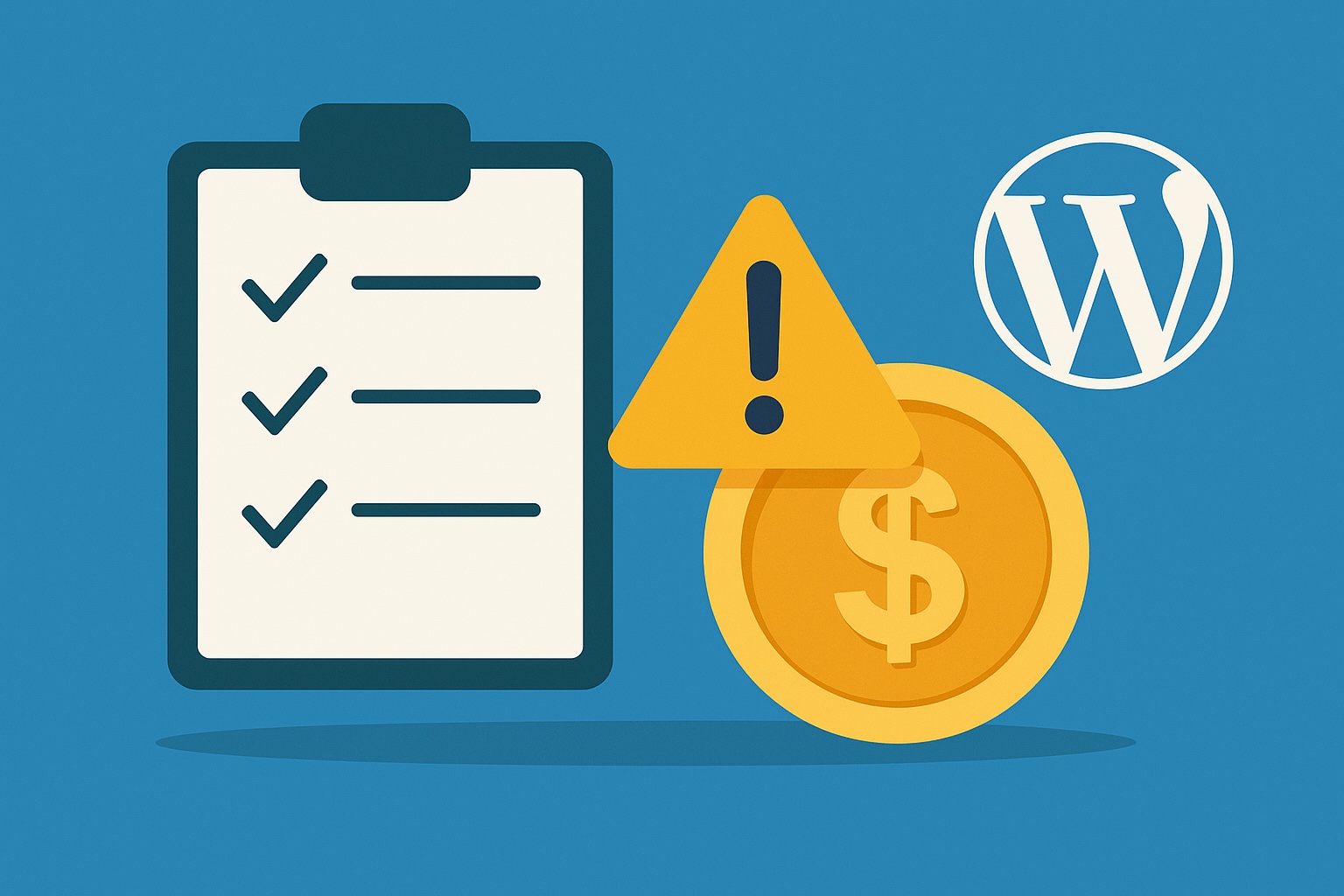Introduction
For enterprise websites, WordPress is more than a publishing platform — it is the digital backbone of business operations, customer engagement, and revenue generation. Yet maintenance is often postponed in favor of short-term cost savings. In reality, neglecting maintenance leads to far greater expenses: lost revenue from downtime, higher security risk, compliance exposure, and persistent damage to search visibility. This article outlines the real cost of skipping maintenance and why enterprises should treat it as a strategic investment in 2025.
Table of Contents
Financial Loss from Downtime
When mission-critical websites go offline, costs escalate fast. For commerce and subscription businesses, even brief outages can derail transactions, inflate support volumes, and erode user trust. Internal teams also lose access to workflows that depend on your CMS: editorial pipelines, campaign launches, and data sync jobs.
- Revenue loss: Abandoned carts and failed checkouts.
- Operational disruption: Editors can’t publish; marketing can’t push campaigns; data teams can’t export reports.
- Support overhead: Contact centers and social channels get flooded during outages.
The exact cost per minute varies by industry and traffic profile, but it consistently dwarfs the expense of routine maintenance. Resilience is cheaper than recovery.
Internal reference: WordPress Maintenance and Support services
Security Breaches and Data Loss
Outdated WordPress core, plugins, or themes create well-known attack surfaces. Automated scanners look specifically for versions with disclosed CVEs. Skipping updates compounds risks over time: a single outdated dependency can enable privilege escalation, stored XSS, or even remote code execution.
- Data breaches: Exposed PII triggers notifications and legal exposure.
- Malware injections: Spam links and malicious redirects hurt users and rankings.
- Ransomware: Encrypted files and databases halt operations and recovery is costly.
For a current benchmark of breach impact, see IBM’s annual report (IBM Cost of a Data Breach Report https://www.ibm.com/reports/data-breach). The numbers vary by sector, but the trend is consistent: unpatched systems materially increase breach likelihood and cost.
External references:
Internal reference: WordPress VIP Partner (governance, code standards, SLAs)
SEO Penalties and Lost Visibility
Neglected maintenance undermines organic visibility through multiple mechanisms:
- Core Web Vitals drift: Asset bloat, render-blocking scripts, and DB inefficiencies degrade LCP/INP/CLS.
- Security flags: Malware or cloaking can trigger manual actions and Safe Browsing warnings.
- Content decay: Broken links, stale metadata, missing schema, and outdated internal linking reduce topical authority.
Once rankings drop, the recovery curve is slow — even after you fix the underlying issues. Search engines reward consistent quality and reliability, not sporadic improvements.
External reference: Google Search Central SEO Starter Guide
Internal references:
Compliance Failures and Regulatory Fines
If you operate in regulated environments (finance, healthcare, media with paid subscribers), maintenance underpins your compliance posture:
- Patch governance: Many frameworks expect timely remediation of known vulnerabilities.
- Logging and auditability: Missing updates can break audit trails or leave logging incomplete.
- Incident handling: Outdated stacks complicate forensics and elongate recovery windows.
While specific obligations vary, the principle is the same: “reasonable security” presumes you keep software current and follow hardening guidance.
External references:
Internal reference: WordPress VIP Partner (standards & review process)
Long-Term Technical Debt
Postponing maintenance accumulates debt across your stack:
- Dependency rot: Plugins go unmaintained; themes stop receiving updates; PHP versions get deprecated.
- Incompatibilities: Future migrations become risky and costly as gaps widen.
- Operational drag: Engineers spend more time firefighting than shipping improvements.
Debt is not just a developer concern — it is an executive risk. It inflates time-to-market and constrains your roadmap.
Internal reference: WordPress Maintenance and Support services
Case Study Scenario: Neglect vs. Proactive Care
Consider two similar enterprise publishers. The first deferred plugin updates for 12 months. A known vulnerability was exploited to inject spam links across thousands of articles. Cleanup required emergency developers, multi-day search remediation, and reprocessing of sitemaps. The indirect costs — lost traffic and advertiser confidence — persisted for months.
The second publisher followed a strict maintenance cadence: weekly dependency reviews, monthly performance audits, and security patching within 24–48 hours. When a comparable vulnerability surfaced, their staging tests validated the fix the same day and the patch went live without incident. Their total maintenance budget was a small fraction of the first publisher’s recovery spend.
The ROI of Proactive Maintenance
Proactive maintenance yields measurable returns:
- Reduced downtime: Fewer incidents and shorter MTTR when issues arise.
- Lower breach probability: Patched surfaces and hardening controls.
- Stable SEO: Consistent Core Web Vitals, clean sitemaps, and current schemas.
- Audit-ready posture: Evidence of control operation (updates, backups, tests).
The financial argument is straightforward: routine maintenance is predictable OPEX; emergency remediation is unpredictable CAPEX with reputational externalities.
External reference: IBM Cost of a Data Breach Report
Practical Maintenance Blueprint (2025)
If you need a concrete starting point, align on the following baseline:
- Updates & patching:
- Core and security releases within 24–72 hours; feature updates after staging verification.
- Plugin/theme reviews weekly; remove unused components.
- Track PHP and MySQL version support windows.
- Backups & restore tests:
- Daily off-site backups; versioned, encrypted.
- Monthly restore drills with documented RTO/RPO outcomes.
- Performance management:
- Quarterly Lighthouse and WebPageTest baselines.
- Full-page caching, object caching, image optimization (WebP/AVIF).
- Query profiling for heavy templates and search endpoints.
- Security hardening:
- WAF, MFA for admin, least-privilege roles, CSP/HSTS headers.
- Scheduled malware scans and dependency monitoring.
- Observability & DR:
- Uptime monitoring with alerts; centralized logs.
- Incident runbooks with clear ownership and escalation.
Conclusion
Neglecting WordPress maintenance exposes enterprises to costs that far exceed the price of routine care. The true impact spans finances, security, SEO, and compliance — and it compounds over time. Treat maintenance as a standing capability with defined SLAs, not an ad-hoc task. Organizations that invest in proactive maintenance safeguard revenue, reduce risk, and maintain strategic velocity in 2025.







